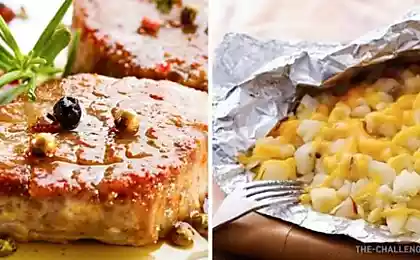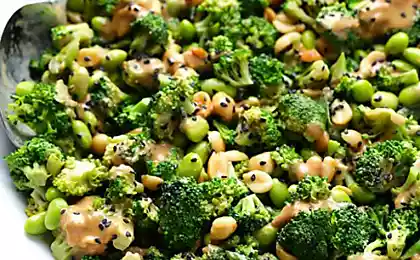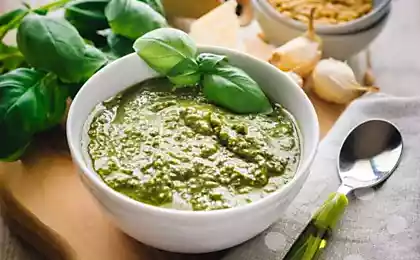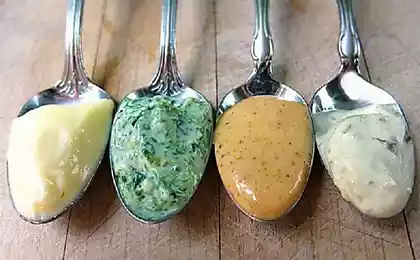489
Pesto three delicious sauce recipe
Pesto especially nice to have in your culinary repertoire in the summer. He is decorated with freshly cut tomatoes, pickled cheese, all that can come to mind to fry on the grill (from bread to eggplant, peppers, zukkini, steak, chicken, fish and shrimp), what to stop doing it once is not desirable.
Especially considering how fast and simple to do it and how easy the recipe is adaptable to your existing ingredients.
Fourteen million eighty eight thousand eight hundred eleven
The variants of pesto
Most people faced with only one kind pesto – Genoese. This is the sauce of green Basil with pine nuts, garlic, olive oil and cheese — Parmesan and/or aged sheep cheese (original — Fiore Sardo, and we have the most suitable analogue – ear).
In Liguria, the Genoese pesto, first of all, fill the pasta. Long or short. It is cooked along with diced potatoes and green beans, and then throw back and add pesto. Potatoes while stirring disperses into a puree and is formed of a single intensely green sauce. But also easy to meet this pesto as a seasoning for vegetable soup (minestrone) or as a Supplement to meats.
The Genoa option and in fact very old, but the word "pesto» means only "pounded in a mortar". And, of course, many other ideas were not slow to appear. For example, at nearby Provence appeared sauce "piste", which is prepared as well, but without the nuts and sometimes without cheese. To the Basilica often mixed with parsley. Fill them with the vegetable soup (which is called "soup of the piste"), boiled and baked potatoes, beans, zucchini, or just smear it on bread.
On the way to the South of Italy are found more interesting discoveries. In Tuscany, the Basilica was added to rocket. There figured to add a bit of cold water to the pasta sauce turned out lighter and more enveloping. In Tuscany there is another, completely different version of pesto with fresh thyme, sage and rosemary.
But in Sicily and in Calabria culinary thought is really cool turned. There began to prepare pesto with tomatoes or sweet peppers. Sometimes with pine nuts and sometimes almonds. Or without nuts, but with a young ricotta in addition to aged Parmesan – in this case, the consistency of the sauce is simply wonderful. in the South pesto often served for appetizers fried in batter, especially vegetables and zucchini flowers stuffed with mozzarella. But paste of course, also is charged.
The rest of the world thought, too, not stood. In Germany, the pesto started to do from garlic. There are options with cilantro, spinach, hazelnuts, walnuts and mushrooms.
I love pesto celery, and my other half makes it takes to mint and roast lamb.
Ninety nine million eight hundred thirty nine thousand three hundred thirty four
The principle pesto
Ingredients can be manipulated quite freely, knowing the General principle.
Basic herbs/vegetable with nature, we need to give the basic taste of the sauce. For example, green Basil, red Basil, cilantro, parsley, arugula, celery, mint, thyme, sage. You can mix several different herbs, if you like the combination. Or add spinach to slightly dilute the main greens. Alternatively you can take a tomato or sweet pepper.
Nuts and cheese are responsible for the consistency and thickness of the sauce. If you don't put neither one not the other, you will get just easily cleavable mashed ground green. In addition, they bring additional taste. Aged Parmesan or Pecorino, is the most aggressive. If you want a mild sauce, not clogging the delicate taste of the dish, you can add them quite a bit or even left aside.
Ricotta is almost neutral. From pine nuts (or cedar, in our latitudes makes a lot of sense) comes the sweetness. From walnuts – a bit of bitterness. It may be the almonds, and hazelnuts, and cashews, and you will surely find more options.
Olive oil and water make the sauce fluid. The less oil, so it will be thicker. Nice thick to smear on bread, to serve with soup or as an addition to vegetable and meat snacks. If you run the pasta, it makes sense to make it more liquid. You can just add a little more oil or to replace part of the butter with ice water sauce turns out very beautiful light and enveloping.
Oil, by the way, doesn't have to be olive. Use the one that you like the food. Different nutty and even unrefined sunflower can in good combination with the main ingredient to give a great result.
Spices help to balance the resulting sauce to taste. Garlic, salt, black, white or chili peppers, sugar, just try and add them to your liking.
The proportions for the three pesto
Genoese Basil: single beam (60 g) green Basil 30 g pine nuts, 20 g of Parmesan cheese or Grana Padano, 40-60 ml of olive oil, one clove of garlic, salt and black pepper to taste.
Calabrian pepper: one red bell pepper (150 g), 50 g ricotta, 30 g Parmesan cheese or Grana Padano, 30 g of cheese, Pecorino Romano, 60-80 ml of olive oil, sprig of Basil, salt and chili powder to taste.
Sicilian tomato: 150 g tomatoes, 50 g peeled almonds 50 g Parmesan cheese or Grana Padano, 80-120 ml of olive oil, one clove of garlic, sprig of Basil, salt and black pepper to taste.
Technology pesto
Greens wash, dry and remove quite thick branches (thin it is better to leave). The tomatoes remove the stem. From peppers, remove the stalk, seeds and membrane and fry them until soft in olive oil. Cheese – grate.
Traditionally the sauce is done in a mortar, but it is physically hard and long. I always do in a food processor or chopper. Blender (with a small knife at the bottom of the bowl) copes worse, but is also an option.
First, chop the herbs / vegetables along with nuts and garlic. Then add the cheese and a bit of oil and again grind. In a few receptions add the remaining oil. Try it, add salt and pepper to taste. Keep in mind that the sauce is already salty cheese.
The prepared sauce can be a few days stored in the refrigerator, then it should close tightly, and preferably, pour over top of butter layer. If you need to store longer, place in plastic container in the freezer. And when thawed, re-blend, if necessary diluted with water or oil. published
P. S. And remember, only by changing their consumption — together we change the world! ©
Source: www.gastronom.ru
Especially considering how fast and simple to do it and how easy the recipe is adaptable to your existing ingredients.
Fourteen million eighty eight thousand eight hundred eleven
The variants of pesto
Most people faced with only one kind pesto – Genoese. This is the sauce of green Basil with pine nuts, garlic, olive oil and cheese — Parmesan and/or aged sheep cheese (original — Fiore Sardo, and we have the most suitable analogue – ear).
In Liguria, the Genoese pesto, first of all, fill the pasta. Long or short. It is cooked along with diced potatoes and green beans, and then throw back and add pesto. Potatoes while stirring disperses into a puree and is formed of a single intensely green sauce. But also easy to meet this pesto as a seasoning for vegetable soup (minestrone) or as a Supplement to meats.
The Genoa option and in fact very old, but the word "pesto» means only "pounded in a mortar". And, of course, many other ideas were not slow to appear. For example, at nearby Provence appeared sauce "piste", which is prepared as well, but without the nuts and sometimes without cheese. To the Basilica often mixed with parsley. Fill them with the vegetable soup (which is called "soup of the piste"), boiled and baked potatoes, beans, zucchini, or just smear it on bread.
On the way to the South of Italy are found more interesting discoveries. In Tuscany, the Basilica was added to rocket. There figured to add a bit of cold water to the pasta sauce turned out lighter and more enveloping. In Tuscany there is another, completely different version of pesto with fresh thyme, sage and rosemary.
But in Sicily and in Calabria culinary thought is really cool turned. There began to prepare pesto with tomatoes or sweet peppers. Sometimes with pine nuts and sometimes almonds. Or without nuts, but with a young ricotta in addition to aged Parmesan – in this case, the consistency of the sauce is simply wonderful. in the South pesto often served for appetizers fried in batter, especially vegetables and zucchini flowers stuffed with mozzarella. But paste of course, also is charged.
The rest of the world thought, too, not stood. In Germany, the pesto started to do from garlic. There are options with cilantro, spinach, hazelnuts, walnuts and mushrooms.
I love pesto celery, and my other half makes it takes to mint and roast lamb.
Ninety nine million eight hundred thirty nine thousand three hundred thirty four
The principle pesto
Ingredients can be manipulated quite freely, knowing the General principle.
Basic herbs/vegetable with nature, we need to give the basic taste of the sauce. For example, green Basil, red Basil, cilantro, parsley, arugula, celery, mint, thyme, sage. You can mix several different herbs, if you like the combination. Or add spinach to slightly dilute the main greens. Alternatively you can take a tomato or sweet pepper.
Nuts and cheese are responsible for the consistency and thickness of the sauce. If you don't put neither one not the other, you will get just easily cleavable mashed ground green. In addition, they bring additional taste. Aged Parmesan or Pecorino, is the most aggressive. If you want a mild sauce, not clogging the delicate taste of the dish, you can add them quite a bit or even left aside.
Ricotta is almost neutral. From pine nuts (or cedar, in our latitudes makes a lot of sense) comes the sweetness. From walnuts – a bit of bitterness. It may be the almonds, and hazelnuts, and cashews, and you will surely find more options.
Olive oil and water make the sauce fluid. The less oil, so it will be thicker. Nice thick to smear on bread, to serve with soup or as an addition to vegetable and meat snacks. If you run the pasta, it makes sense to make it more liquid. You can just add a little more oil or to replace part of the butter with ice water sauce turns out very beautiful light and enveloping.
Oil, by the way, doesn't have to be olive. Use the one that you like the food. Different nutty and even unrefined sunflower can in good combination with the main ingredient to give a great result.
Spices help to balance the resulting sauce to taste. Garlic, salt, black, white or chili peppers, sugar, just try and add them to your liking.
The proportions for the three pesto
Genoese Basil: single beam (60 g) green Basil 30 g pine nuts, 20 g of Parmesan cheese or Grana Padano, 40-60 ml of olive oil, one clove of garlic, salt and black pepper to taste.
Calabrian pepper: one red bell pepper (150 g), 50 g ricotta, 30 g Parmesan cheese or Grana Padano, 30 g of cheese, Pecorino Romano, 60-80 ml of olive oil, sprig of Basil, salt and chili powder to taste.
Sicilian tomato: 150 g tomatoes, 50 g peeled almonds 50 g Parmesan cheese or Grana Padano, 80-120 ml of olive oil, one clove of garlic, sprig of Basil, salt and black pepper to taste.
Technology pesto
Greens wash, dry and remove quite thick branches (thin it is better to leave). The tomatoes remove the stem. From peppers, remove the stalk, seeds and membrane and fry them until soft in olive oil. Cheese – grate.
Traditionally the sauce is done in a mortar, but it is physically hard and long. I always do in a food processor or chopper. Blender (with a small knife at the bottom of the bowl) copes worse, but is also an option.
First, chop the herbs / vegetables along with nuts and garlic. Then add the cheese and a bit of oil and again grind. In a few receptions add the remaining oil. Try it, add salt and pepper to taste. Keep in mind that the sauce is already salty cheese.
The prepared sauce can be a few days stored in the refrigerator, then it should close tightly, and preferably, pour over top of butter layer. If you need to store longer, place in plastic container in the freezer. And when thawed, re-blend, if necessary diluted with water or oil. published
P. S. And remember, only by changing their consumption — together we change the world! ©
Source: www.gastronom.ru























